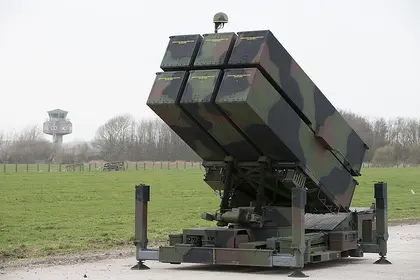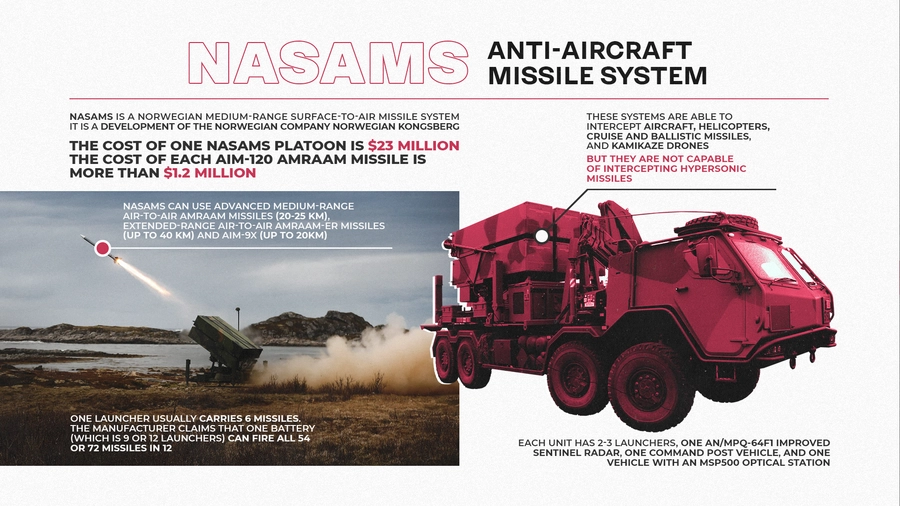In the summer, during his visit to Ukraine, Lithuanian President Gitanas Nausėda announced that Lithuania plans to purchase and transfer to Kyiv two modern launchers for the NASAMS anti-aircraft missile system.
JOIN US ON TELEGRAM
Follow our coverage of the war on the @Kyivpost_official.
The Lithuanian embassy confirmed the information and said that Ukraine would receive the latest modification of the system. The total value of the contract is estimated at around €10 million. The transfer of these air defence systems is expected to take place in early October.
NASAMS capabilities
NASAMS is a modern medium-range air defence system, made in partnership between Norway’s Kongsberg and the US’ Raytheon. The name of the system consists of the abbreviation NASAMS, which stands for Norwegian Advanced Surface to Air Missile System.
NASAMS is a highly mobile system specially designed to protect a variety of targets. Typically, these systems defend air bases, seaports, military units and other important facilities.
Design history
NASAMS engineering began in 1989. The system was tested for 4 years and was taken into service by the Norwegian Air Force in 1994.
NASAMS was developed to replace the then outdated Improved Hawk air defence system. The new air defence system was to be universal and meant to protect against aircraft, helicopters, drones and cruise missiles.
During the tests, the Norwegian military noted the high efficiency of this system against cruise missiles. Subsequently, the system underwent several improvements.

Latest on Russia’s Intransigence to End War Against Ukraine
In 1999, an improved version of NASAMS 2 was introduced. The updated system received an improved AN/MPQ-64F1 radar, a new optoelectronic station, and an upgraded command post. The second generation of NASAMS was also able to work with the Link-16 information exchange system.
Link 16 is a military data network that provides real-time information. It is used by the United States and all NATO countries and is part of the Tactical Digital Communications Network system. This data communication, navigation and identification system supports the exchange of information between tactical command, aircraft, ships and ground forces.
The latest version, NASAMS 3, was launched in 2019. The most modern generation of NASAMS has a completely updated command post and launch containers adapted to use short-range AIM-9X Sidewinder missiles (with an infrared homing head) and AMRAAM-ER (Extended range) missiles.
The extended-range missiles are capable of shooting down targets at a distance of 40 kilometres and at an altitude of 21 kilometres. NASAMS continues to be improved today. For example, in October 2021, Raytheon announced its intention to integrate the new GhostEye MR radar into the system.
"Over the past 10 years, NASAMS has become the best-selling air defence system in its class. Its modularity and open architecture enable continuous performance improvement to counter modern threats," said Harald Annestad, President of Kongsberg Defence Systems.
But this has not always been the case. At the very beginning of its existence, NASAMS was not very popular on the international arms market. For decades, this air defence system was in service only in Norway.
However, after the events of 11 September 2001, many countries revised their defence strategies. Immediately afterwards, the United States purchased these systems to strengthen the air defence of Washington DC.
Since then, the system has been protecting the White House and has come into service in Australia, Chile, Finland, Indonesia, Lithuania, the Netherlands, Spain, Hungary, and Ukraine.
NASAMS has become so popular that in advertising materials, the letter N in the abbreviation no longer stands for Norwegian, but for National.
How NASAMS work
NASAMS is capable of using various types of US air-to-air missiles. In NASAMS, these missiles have been optimised for ground launch from special containers. Each launcher has 6 containers with one missile in each. A conventional AIM-120A AMRAAM missile can shoot down targets at a distance of 20-25 kilometres at altitudes of 30 metres to 16 kilometres.
If the target is at a greater distance, it is possible to use AMRAAM ER (Extended Range) missiles with a range of up to 40 kilometres.
A NASAMS battery may include a different number of launchers, but typically a battalion consists of three firing platoons. Each platoon has 2-3 missile launchers, one AN/MPQ-64F1 Improved Sentinel radar, one command post vehicle and one vehicle with an MSP500 optical station. Each firing platoon is capable of operating independently or in cooperation with other platoons in the battery.
To ensure maximum invulnerability of the system, the launchers may be located at a distance of up to 25 kilometres from the command centre or radar. Communication between the system's components can be established via both wired and wireless communications.
One battery consists of 12 launchers with 72 missiles, 8 radars, 1 fire control centre and 1 tactical control vehicle. The battery's firing time with the entire ammunition package is no more than 12 seconds.
The other important component of the anti-aircraft system is the AN/MPQ-64 Sentinel radar. This radar has a compact design and can be mounted on a small single-axle trailer. The detection range of fighter aircraft targets is 60 kilometres. The radar can simultaneously track up to 60 targets and guide three missiles to selected targets.
It is also worth noting that each of the three missiles aimed at the same target can be launched from different launchers, which can be located tens of kilometres away from each other.
The three platoons form a battery with a common information network. This means that each radar can provide targeting guidance for launchers not only for its own unit, but also for others.
Today in Kyiv I told my dear friend President @ZelenskyyUa that Lithuania will keep supporting Ukraine until victory.
— Gitanas Nausėda (@GitanasNauseda) August 23, 2023
Lithuania will deliver NASAMS launchers to Ukraine next month.
🇱🇹🤝🇺🇦 pic.twitter.com/cxDnB3FX6G
NASAMS in Ukraine
Ukraine received its first NASAMS air defence systems in November 2022. In the first 5 months of operation, these systems shot down more than 100 Russian cruise missiles.
The Ukrainian military is very enthusiastic about the Norwegian system. The manufacturer claims that the system's efficiency is about 85%, but, according to Pentagon chief Lloyd Austin, it is not uncommon for the system in Ukraine to shoot down 100% of its targets.
You can also highlight the text and press Ctrl + Enter














